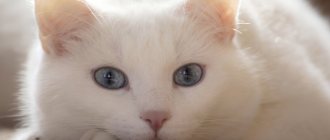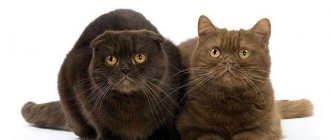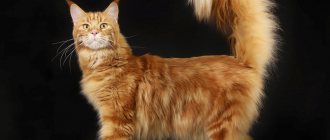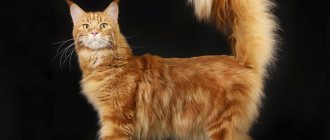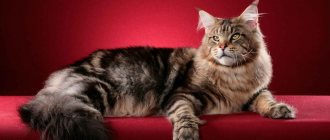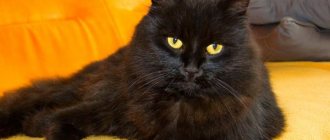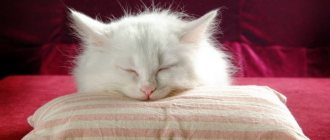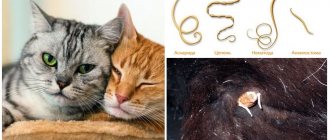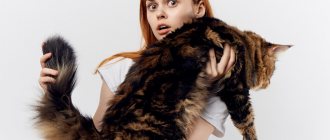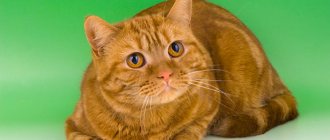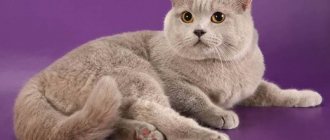To designate the “raccoon cat” standard, felinologists have adopted the EMS code system. Breeders study the genetic predisposition of pets to a certain color and fur pattern. The main names and their variations have been studied, depending on the tone, location of stripes and figures on the wool. The expected shade of the pet's eyes is known.
Tabby (Tabbies)
If your cat has stripes on his coat, then the color of this Maine Coon is called “tabby” or “brindle”. All tabbies have thin lines on their muzzle that expressively outline their eyes, and on their forehead lines that form the letter “M.” If you look at the fur close up, you will notice that each hair is colored with dark and light stripes. This alternation is called "Agouti". It is commonly believed that tabby is the original color of wild cats.
There are four main tabby patterns:
Mackerel tabby (brindle)
- a pattern in the form of parallel vertical stripes.
Classic tabby (classic)
- wide spiral stripes on the sides, reminiscent of marble stains. In the UK this pattern is called "blotched tabby".
Spotted tabby - (spotted).
Spots throughout the body in the form of intermittent stripes.
Ticked tabby
- sometimes called Abyssinian or agouti. Without stripes or spots on the body, but with a pattern on the face and agouti on the body. This color is typical for Abyssinian cats, but it also occurs in other cats. Ticked colors are not recognized in the Maine Coon breed.
Tabbies come in a wide variety of colors. Tabby color refers to the color of the stripes or the tip of the tail. The main color of agouti varies from faded blue to deep red.
Maine Coon cat, black silver tabby color ns 22
Maine Coon cat red silver tabby ds 22
Maine Coon cat, cream tabby color MCO e 22
Maine Coon cat color black tabby with white (black classic tabby with white) n 09 22
Maine Coon cat, black tabby color (black-classic-tabby) MCO n 22
Maine Coon cat brown mackerel tabby
Maine Coon cat color brown spotted with white (brown mackerel spotted / white) f 09 24
Maine Coon cat brown tabby color
A little history
These kittens are known for their high intelligence and self-confidence. The very name of this breed translates as “cat raccoons”. Indeed, their coat is very similar to that of raccoons.
Thanks to climatic conditions, Maine Coon kittens have such a thick coat. In the places where representatives of this breed were bred, the main emphasis was on agriculture. And such animals helped in becoming excellent mouse hunters. Therefore, the goal of the breeders was to breed pets that would be huge in size and lead an active lifestyle. This is exactly how these kittens turned out.
Starting from the 50s of the 19th century, Maine Coons began to take part in various cat shows. Thanks to this, such animals have become quite famous in many large and small towns in America. This breed began to compete with other known species. They were as popular as Persian or Angora cats.
But already in the twentieth century, interest in such cats began to gradually fade away. These animals again became helpers in the household. And starting from 1953, the breeding of representatives of this breed began to be actively pursued again. Thus, cats have become popular again not only in the USA, but also in other countries and continents. They again began to take first place in the ranking of furry animals. Many people began to purchase them so that their pets would please their eyes and become friends for all family members.
Maine Coon, the description of the breed, perhaps encourages many animal lovers to find out as much information as possible about the pet. Thus, it is known that the approximate time when people started talking about the breed seriously was no less than half a century ago.
It is quite possible that the Maine Coon, whose video is very popular on the Internet, is the result of a successful crossing of short-haired cats living in New England, in Maine, with imported long-haired cats that came to the territory thanks to the movement of traders. However, this, again, is one of the well-known versions.
It was widespread in America in the nineteenth century. It is worth saying that at that time Maine Coon kittens, whose photos now cause delight among many, did not attract the public attention they deserved. And this lasted until the breed was presented at the exhibition.
It is known that the black Maine Coon received a winner's medal, which has been preserved to this day and is in the CFA club.
With the advent of the nineteenth and twentieth centuries, cats with pointy ears again became unpopular, and interest in them fell sharply. What this is connected with is unknown.
But, a few years later, already in the mid-twentieth century, fans of the Maine Coon animal began to correct the situation. Their photos were collected and presented in specialized clubs.
And what pushed them to take such a serious step was the announcement that the breed could be considered extinct... Thanks to considerable efforts, by 1956 it was possible to create a standard for individuals of this breed.
Almost twenty years later, the club was considered a serious organization and was treated with due respect. Currently, the adult Maine Coon ranks third in popularity. At the same time, it is worth adding that the first two places belong to exotic cats, the interest in which is quite obvious.
Solid colors
If a cat is completely the same color, it means it is “solid”. Solid colors were developed due to the suppression of recessive tabby genes. There are cases when the pattern is not completely suppressed, then a fuzzy shadow tabby is noticeable. If you look at a black leopard, you can see the outline of the pattern, since the leopard also has similar suppressed genes.
Cream and red colors cannot suppress tabbies effectively, so the pattern on these animals is always present to a greater or lesser extent. The monochromatic white color is obtained by the action of different genes that completely suppress the color. Many white kittens have vague shades on the head, where the color is not completely suppressed, this goes away with age.
Black MCO n
Blue MCO a
Red MCO d
Cream MCO e
White MCO w
Story
This is not a man-made species at all, but an aboriginal breed created by nature in the northern state of the USA. It was there, in Maine, where the climate is quite harsh, that large domestic cats were born. The result of this increased size is not a gene mutation at all, but due to natural selection.
It is not so easy to survive in harsh climatic conditions; this is only possible for the largest animals covered with warm fur. And so it turned out that from each litter only the tallest and strongest kittens survived. Gradually the breed became larger.
At the end of the eighteenth century, breeders in large cities drew attention to the unusual nature of cats. Local residents have long been accustomed to the fact that their giant assistants do an excellent job of exterminating rodents, but they did not have enough time to think about the unusual nature of their pets
It’s a completely different matter when such specimens fall into the hands of felinologists. The first standards were registered already at the beginning of the nineteenth century. But the peak of popularity and world fame began for them at the end of the century.
Captain Jenks of the Marine Cavalry was the long and unusual name of the first Maine Coon to win the show in 1861. It would seem that this is the moment of glory, but our heroes are crossed by fluffy Persians and all the love and popularity goes to them. But large mousecatchers were appreciated by farmers from all states of America, and due to such demand, the breed managed to survive.
Today they are held in high esteem again. They are loved by families with children, single people, professional breeders and just cat lovers. But we must not forget that these gentle giants have not only advantages, but also disadvantages.
Smoky colors (Smokis)
If the cat is black or blue in color, but the roots of the hairs are clearly white, then it is “smoke”. Solid-colored cats usually have grayish hair roots; true smokes have distinct white roots. Smokes are a solid variant of the silver tabby. This color is very mysterious and impressive, especially in movement with a beautiful play of color.
Smoky colors are divided according to the length of the dyed hair into the following types:
Chinchilla
– 1/8 of the hair tip is dyed.
Shaded
– 1/4 of the end of the hair is dyed.
Smoky
– 1/2 of the end of the hair is dyed.
Black smoke
- black color with white roots.
Blue smoke
– blue color with white roots.
Silver (Shaded/Chinchilla)
- at birth, kittens have fur so light that it appears white. White color can only be inherited from white parents (not silver). A small tabby pattern is sometimes possible at the tip of the tail, which usually disappears by six weeks. A sign that the kitten is silver and not white is green eyes.
Red (cream) shaded or smoky color Cameo (Cameo)
— kittens of this color are usually born white, and tipping appears gradually.
Maine Coon cat, black smoke color MCO ns
Maine Coon cat color blue smoke MCO as
Maine Coon cat, red smoke color MCO ds
Features of the character and care of animals
Maine Coons are very observant animals, as scientists have proven, they can do conscious actions. Not many felines can raise their offspring together, but a cat and a Maine Coon cat do it together. These cats have an excellent memory, which allows them to remember several commands from their owner.
Animals are peaceful and therefore try to adapt to a person’s regime and habits.
Cats will get along well with other animals and children, as they love to be held. It takes time for a pet to get used to a new person, so cats treat guests with caution. Maine Coons are very loyal animals, this devotion is comparable to that of a dog, and they are also easy to train. These are very energetic pets, they need to move a lot, there must be enough space for this.
Even though this is a pet, it still needs to be walked outside at least several times a week.
Since Maine Coons have very long and thick fur, it requires careful and constant care. To prevent the fur from getting tangled, it should be combed; for this, special combs with rounded teeth are used, this is necessary so as not to injure the delicate skin of the animal. Cats love to wash themselves and are neutral towards water, so they can be washed easily. The ears of these animals are a weak point, they should be given special attention, they need to be cleaned with a soft cloth, the inner surface of the shells should have a pink tint.
Maine Coons love high places, so their personal space should be high. Owners who live on the upper floors should be careful about open windows in the rooms. Since Maine Coons are large, they cannot group themselves correctly when falling, which is why accidents happen to animals.
Animals love meat, so they must have it in their diet, but you shouldn’t chop it finely; chewing food will strengthen the cats’ jaws. The diet should not contain fish, milk, and cats should not be given pork or lamb. Kittens of this breed are born quite large in size, they are very playful and active, they are almost always busy, and when they find themselves in an unfamiliar place, they will completely explore the room. You can buy Maine Coon kittens at the age of 12 weeks and above.
You can buy kittens in a specialized nursery, the price for them is not small. Here everything will depend on the color, gender and age of the animal, and it is also worth considering why the pet will be acquired. If the animal will not be shown at exhibitions, and there are slight deviations from certain standards, then their price starts from 20,000 rubles. Of course, on the Internet there are a lot of advertisements for the sale of these kittens at a lower price, but they are usually not purebred. And it is worth remembering that the natural colors of Maine Coons will always cost much more.
In order to have such an animal, you need to count on your caregiving efforts, free time, and also money for decent maintenance of these big cats.
You will learn more about marbled Maine Coons in the following video.
Source
With white markings
White markings, clearly defined (as opposed to the shaded spots of the Siamese) can be present on any color. You just need to add “With white (and white)” to the description of the main color. So, for example, you get “Black and White” or “Cream and White”.
The white areas may vary in size and location, and the most accurate name for the color depends on this:
With white medallion (locket)
- There is a white spot on the chest.
With white gloves (mitted)
– white slippers on the paws.
With white buttons
– the presence of one or more small white spots.
Bicolor (bi-color)
– half white.
Harlequin
- white with several large colored spots.
Van
- all white with color on the tail and head.
Tuxedo (tuxedo)
- white paws and chest. May have some white on head. This definition is informal.
Van
Harlequin
Bi-color
Tuxedo (Tuxedo)
With white medallion (Locket)
With white gloves (Mitted)
Blue marble
Blue kittens range in shades from slate gray to light blue, giving each cat a unique look. Rich blue stripes on a lighter coat look impressive. There are individuals whose hairs are colored in three colors at once: white - blue - gray. With such a wealth of colors, the cat's coat looks shimmering and smooth. Unlike merle, this color was obtained through painstaking breeding by breeders.
Determining the color of future offspring
To determine what color will be obtained when crossing animals of a certain color, a special color table is used. There are also special color calculators on the Internet that automatically calculate the color of future offspring. To do this you need to specify:
- presence of silver, white spots;
- EMS breed coding;
- main color;
- drawing;
- gender of both parent animals.
By the way, the gender of the animal is also coded. The cat is designated by the numbers 1.0, the cat is assigned the code 0.1.
In general, the health of Maine Coons has no connection with color, but there are exceptions. So, you cannot cross white individuals.
The colors of Maine Coon cats come in a wide range of colors. Amazing combinations of patterns and colors, stripes and spots give their magnificent wool a special sophistication and original appearance. The color of the Maine Coon to a certain extent determines the price, but is not the determining factor. To breed good offspring, the more important parameter is the breed type of the cat and its health status.
EMS code system
It was invented to make it easier for breeders and owners to navigate the smallest nuances of coloring, as well as for the convenience of judges evaluating Maine Coons.
The developed encoding consists of Latin letters and numbers, the combination of which determines the color of an individual individual. Each color has its own letter designation:
- N – black;
- D – red;
- E – cream
- W – white
- A – blue (lightened with N);
- F – tortoiseshell (found only in females);
- G – blue-cream (the result of tortoiseshell oxidation).
In addition, the Latin S appears in the name of the color if a silver tint is observed in the animal’s coat.
Important! The following colors not allowed by the standard are excluded from the EMS table: brown, lilac, fawn, chocolate, color-point (Siamese), gold and fawn (straw).
The presence of white color in wool is indicated by numbers: the larger they are, the higher the content of pigmented hair.
- 01 – white or almost white (with small spots on the head/shoulders or a colored tail).
- 02 – harlequin. Close to 01, but has more colored spots on the back;
- 03 – two-color, when half of the coat is bleached;
- 09 – white areas are insignificant and are located more often on the chest/paws.
Codes starting from the second ten describe patterned Maine Coons that meet strict breed standards.
- 21 - tabby (with its own letter designations). The pattern is smooth, clear and contrasts with the main color. The longer the hair, the more blurry and sloppy the tabby looks;
- 22 - marble, with round streaks on the sides. Two lines along the spine and a “butterfly” in the center of the shoulder blades are allowed;
- 23 - brindle (classic). Long clear lines encircling the sides, as well as one wide one along the ridge. If the stripes are intermittent, the pattern is called “mackerel”.
- 24 - spotted, with “mackerel” coloring on the front part of the body and noticeable spotting (“peas”) on the back;
- 25 - ticked, the rarest color option for Maine Coons with the complete absence of tabby.
Thanks to EMS encoding, it is easy and accurate to create a description of any cat, which fits perfectly into official documents, including certificates, veterinary passports and pedigrees.
Return to content
